Nancy Moser's Blog, page 3
August 6, 2014
Pioneers and "the Glorious Fourth"
--Summer Greetings from Stephanie Grace Whitson
How's your summer going? I can hardly believe it's time for back to school sales ... and for me to have not one but TWO grandchildren old enough to start school. Where did the last six year go? But before school starts, we'll be heading to a family reunion "on the beach." While it takes some forethought to manage it, an eight-hour drive for fun isn't really all that unusual for today's families. Back in the 1800s, such a trip would be unthinkable. But that doesn't mean our pioneer foremothers didn't know how to party. July 4 was a huge day for Nebraska'a pioneers.
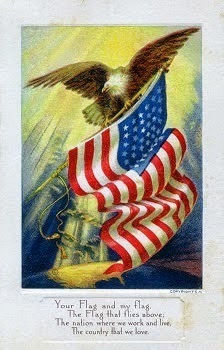 “Now, therefore, I, Silas Garber, governor of the state of Nebraska … do declare said county to be temporarily organized … this twenty-seventh day of June, in the year of our Lord one thousand either hundred and seventy-seven, and of the independence of the United State the one hundred and first, and of this state, the eleventh.” Thus was Custer County, Nebraska, officially created. It’s interesting that the 2,592 square mile county’s first official document references Independence Day. Custer County was a hard place to eke out a living. Houses were built from the prairie sod, and homemakers waged a constant battle against fleas, frogs, and snakes. One early Easter Sunday, neighbors got together with guns, revolvers, rifles, spades, and garden rakes, and killed 133 rattlers. In one day. Even in those early days, though, when towns were little more than a few ramshackle buildings squatting on open prairie, celebrating July 4 was an important event. Early photographer Solomon Butcher photographed one such celebration in 1886. You can see the photograph here: http://memory.loc.gov/award/nbhips/lca/290/2904v.jpg. One pioneer woman remembered a basket dinner on her first Fourth of July—and the singing of patriotic songs by a chorus. She also mentioned “funny stories told to keep up our morale.” A popular song originally titled “The Beautiful Valley of Eden” became “The Beautiful Valley of Clear Creek” in honor of a new settlement. Estell Chrisman Laughlin remembered the “hustle and bustle or preparation a week or so beforehand,” as mothers sewed new dresses for their daughters and cotton suits for their sons. Another woman reminisced, “Mothers spent days sewing, washing, ironing, making button holes, and sewing on buttons, starching and ironing petticoats as stiff as sunbonnets. We wore two or three of those petticoats, ruffles and all. We listened for the guns at sunrise on the Fourth of July morning. There were horse races and baseball games, dancing all afternoon and night, speaking, and other entertainments.” Families arrived in town early to select a meeting place for dinner, which consisted of “great quantities of fried chicken, baked beans, potato salad, sandwiches, brownstone front cake, and gooseberry and raspberry pie—the contents of the pies having been diligently gathered from canyons and creek banks by children … Each housewife wished to impress the others with her culinary proficiency.” Sometimes the lemonade might even be chilled with ice, cut the prior winter and stacked in an ice house or barn, protected from melting for as long as possible by being covered over with straw and gunny sacking. Mrs. Laughlin remembered a Judge Matthews who “reeked of tobacco,” but was popular with the children, “for he could write our named in red and blue fancy script on a little card which he decorated with a graceful winging bird holding a scroll in its beak.”
“Now, therefore, I, Silas Garber, governor of the state of Nebraska … do declare said county to be temporarily organized … this twenty-seventh day of June, in the year of our Lord one thousand either hundred and seventy-seven, and of the independence of the United State the one hundred and first, and of this state, the eleventh.” Thus was Custer County, Nebraska, officially created. It’s interesting that the 2,592 square mile county’s first official document references Independence Day. Custer County was a hard place to eke out a living. Houses were built from the prairie sod, and homemakers waged a constant battle against fleas, frogs, and snakes. One early Easter Sunday, neighbors got together with guns, revolvers, rifles, spades, and garden rakes, and killed 133 rattlers. In one day. Even in those early days, though, when towns were little more than a few ramshackle buildings squatting on open prairie, celebrating July 4 was an important event. Early photographer Solomon Butcher photographed one such celebration in 1886. You can see the photograph here: http://memory.loc.gov/award/nbhips/lca/290/2904v.jpg. One pioneer woman remembered a basket dinner on her first Fourth of July—and the singing of patriotic songs by a chorus. She also mentioned “funny stories told to keep up our morale.” A popular song originally titled “The Beautiful Valley of Eden” became “The Beautiful Valley of Clear Creek” in honor of a new settlement. Estell Chrisman Laughlin remembered the “hustle and bustle or preparation a week or so beforehand,” as mothers sewed new dresses for their daughters and cotton suits for their sons. Another woman reminisced, “Mothers spent days sewing, washing, ironing, making button holes, and sewing on buttons, starching and ironing petticoats as stiff as sunbonnets. We wore two or three of those petticoats, ruffles and all. We listened for the guns at sunrise on the Fourth of July morning. There were horse races and baseball games, dancing all afternoon and night, speaking, and other entertainments.” Families arrived in town early to select a meeting place for dinner, which consisted of “great quantities of fried chicken, baked beans, potato salad, sandwiches, brownstone front cake, and gooseberry and raspberry pie—the contents of the pies having been diligently gathered from canyons and creek banks by children … Each housewife wished to impress the others with her culinary proficiency.” Sometimes the lemonade might even be chilled with ice, cut the prior winter and stacked in an ice house or barn, protected from melting for as long as possible by being covered over with straw and gunny sacking. Mrs. Laughlin remembered a Judge Matthews who “reeked of tobacco,” but was popular with the children, “for he could write our named in red and blue fancy script on a little card which he decorated with a graceful winging bird holding a scroll in its beak.”
In the afternoon, the speaker of the day would “discourse in loud, stentorian tones upon patriotism and what our forefathers had done for us. Old Glory floated aloft in the hot summer air. The people sat about on plank seats, patiently listening and fanning themselves. … When the departing fingers of sunlight withdrew through the trees, there was a general roundup of children. We stowed ourselves into carriages, spring wagons, or lumber wagons, where we sat in all dignity on kitchen chairs, as we departed homeward, tired and happy after a glorious Fourth.”
I hope your summer has had some "happy and glorious" moments.Here's one of mine (below)Stephanie
How's your summer going? I can hardly believe it's time for back to school sales ... and for me to have not one but TWO grandchildren old enough to start school. Where did the last six year go? But before school starts, we'll be heading to a family reunion "on the beach." While it takes some forethought to manage it, an eight-hour drive for fun isn't really all that unusual for today's families. Back in the 1800s, such a trip would be unthinkable. But that doesn't mean our pioneer foremothers didn't know how to party. July 4 was a huge day for Nebraska'a pioneers.
 “Now, therefore, I, Silas Garber, governor of the state of Nebraska … do declare said county to be temporarily organized … this twenty-seventh day of June, in the year of our Lord one thousand either hundred and seventy-seven, and of the independence of the United State the one hundred and first, and of this state, the eleventh.” Thus was Custer County, Nebraska, officially created. It’s interesting that the 2,592 square mile county’s first official document references Independence Day. Custer County was a hard place to eke out a living. Houses were built from the prairie sod, and homemakers waged a constant battle against fleas, frogs, and snakes. One early Easter Sunday, neighbors got together with guns, revolvers, rifles, spades, and garden rakes, and killed 133 rattlers. In one day. Even in those early days, though, when towns were little more than a few ramshackle buildings squatting on open prairie, celebrating July 4 was an important event. Early photographer Solomon Butcher photographed one such celebration in 1886. You can see the photograph here: http://memory.loc.gov/award/nbhips/lca/290/2904v.jpg. One pioneer woman remembered a basket dinner on her first Fourth of July—and the singing of patriotic songs by a chorus. She also mentioned “funny stories told to keep up our morale.” A popular song originally titled “The Beautiful Valley of Eden” became “The Beautiful Valley of Clear Creek” in honor of a new settlement. Estell Chrisman Laughlin remembered the “hustle and bustle or preparation a week or so beforehand,” as mothers sewed new dresses for their daughters and cotton suits for their sons. Another woman reminisced, “Mothers spent days sewing, washing, ironing, making button holes, and sewing on buttons, starching and ironing petticoats as stiff as sunbonnets. We wore two or three of those petticoats, ruffles and all. We listened for the guns at sunrise on the Fourth of July morning. There were horse races and baseball games, dancing all afternoon and night, speaking, and other entertainments.” Families arrived in town early to select a meeting place for dinner, which consisted of “great quantities of fried chicken, baked beans, potato salad, sandwiches, brownstone front cake, and gooseberry and raspberry pie—the contents of the pies having been diligently gathered from canyons and creek banks by children … Each housewife wished to impress the others with her culinary proficiency.” Sometimes the lemonade might even be chilled with ice, cut the prior winter and stacked in an ice house or barn, protected from melting for as long as possible by being covered over with straw and gunny sacking. Mrs. Laughlin remembered a Judge Matthews who “reeked of tobacco,” but was popular with the children, “for he could write our named in red and blue fancy script on a little card which he decorated with a graceful winging bird holding a scroll in its beak.”
“Now, therefore, I, Silas Garber, governor of the state of Nebraska … do declare said county to be temporarily organized … this twenty-seventh day of June, in the year of our Lord one thousand either hundred and seventy-seven, and of the independence of the United State the one hundred and first, and of this state, the eleventh.” Thus was Custer County, Nebraska, officially created. It’s interesting that the 2,592 square mile county’s first official document references Independence Day. Custer County was a hard place to eke out a living. Houses were built from the prairie sod, and homemakers waged a constant battle against fleas, frogs, and snakes. One early Easter Sunday, neighbors got together with guns, revolvers, rifles, spades, and garden rakes, and killed 133 rattlers. In one day. Even in those early days, though, when towns were little more than a few ramshackle buildings squatting on open prairie, celebrating July 4 was an important event. Early photographer Solomon Butcher photographed one such celebration in 1886. You can see the photograph here: http://memory.loc.gov/award/nbhips/lca/290/2904v.jpg. One pioneer woman remembered a basket dinner on her first Fourth of July—and the singing of patriotic songs by a chorus. She also mentioned “funny stories told to keep up our morale.” A popular song originally titled “The Beautiful Valley of Eden” became “The Beautiful Valley of Clear Creek” in honor of a new settlement. Estell Chrisman Laughlin remembered the “hustle and bustle or preparation a week or so beforehand,” as mothers sewed new dresses for their daughters and cotton suits for their sons. Another woman reminisced, “Mothers spent days sewing, washing, ironing, making button holes, and sewing on buttons, starching and ironing petticoats as stiff as sunbonnets. We wore two or three of those petticoats, ruffles and all. We listened for the guns at sunrise on the Fourth of July morning. There were horse races and baseball games, dancing all afternoon and night, speaking, and other entertainments.” Families arrived in town early to select a meeting place for dinner, which consisted of “great quantities of fried chicken, baked beans, potato salad, sandwiches, brownstone front cake, and gooseberry and raspberry pie—the contents of the pies having been diligently gathered from canyons and creek banks by children … Each housewife wished to impress the others with her culinary proficiency.” Sometimes the lemonade might even be chilled with ice, cut the prior winter and stacked in an ice house or barn, protected from melting for as long as possible by being covered over with straw and gunny sacking. Mrs. Laughlin remembered a Judge Matthews who “reeked of tobacco,” but was popular with the children, “for he could write our named in red and blue fancy script on a little card which he decorated with a graceful winging bird holding a scroll in its beak.” In the afternoon, the speaker of the day would “discourse in loud, stentorian tones upon patriotism and what our forefathers had done for us. Old Glory floated aloft in the hot summer air. The people sat about on plank seats, patiently listening and fanning themselves. … When the departing fingers of sunlight withdrew through the trees, there was a general roundup of children. We stowed ourselves into carriages, spring wagons, or lumber wagons, where we sat in all dignity on kitchen chairs, as we departed homeward, tired and happy after a glorious Fourth.”
I hope your summer has had some "happy and glorious" moments.Here's one of mine (below)Stephanie

Published on August 06, 2014 07:23
July 29, 2014
Feeding time!
[image error]
Nancy: My husband and I just experienced the joy of the birth of our fifth grandchild last spring. We’re very blessed that all the kiddos live in town and we have the chance to take care of them. But taking care of babies when we’re nearing sixty…
I am amazed at all the different bottle options out there, from the tradition bottle, to ones that are bent at an angle, to those with disposable innards, etc. Formula containing iron, lactose free...
[image error] When I was writing my novel, Masquerade, which was set in 1886, I had to do some research about bottles and milk. Was milk available for purchase in the poorer areas of New York City? And what did bottles look like?
Turns out the issue of getting milk into a baby—when the mother couldn’t nurse—has always been an issue. In medieval times, babies drank from a hollowed out horn. Later on, there were "pap feeders" made of porcelain. And "pap" was often boiled water and flour. Sometimes bread or egg was added.
In the mid-1800’s cow’s milk was shipped in wood barrels and would easily spoil. It was a dairy farmer by the name of Gail Borden who did something about it. He was sailing home to the USA from Europe, when they encountered rough seas. The cows on the ship got seasick and wouldn’t make milk—I never imaged that was possible. The babies on board were crying from lack of milk. Personally, when I look at situations like this, the odds of getting a dairy farmer with foresight on a ship in a storm, with cows that couldn’t produce milk . . . it leads me to know that the entire situation was God-arranged.
[image error]
When Borden got home he started doing experiments with milk and found that it was 87% water. If he boiled it down in an airtight pan, he came up with a condensed version that was resistant to spoilage. On the way to Washington D.C. to get a patent, he met up with a wealthy grocery wholesaler, and together they canned it and tried to sell it. In 1864, the Eagle Brand Consolidated Milk company was formed.
Canned milk was not a huge success. During production, essential fats and nutrients were lost, and people were used to a more watery consistency and a white color (to get the white color, chalk used to be used!) But Borden persevered, and the Civil War was a boon to his business as the troops were sent condensed milk as part of their rations. At one point during the war, Borden produced 300,000 gallons of condensed milk at his Elgin, Illinois plant. It seems that this milk was not a beverage, but just a condensed form of the milk product.
In 1885, John Meyenberg, an immigrant from Switzerland, was producing the first evaporated milk at his Helvetica Milk Condensing Company plant. Soon after, Eldrige Amos Stuart developed a way to process canned, sterilized evaporated milk. By the end of the century, he partnered with Meyenberg and supplied Klondike gold miners milk in 16 ounce cans.
As the twentieth century began, homogenization was implemented, and in 1934, Meyenberg’s company (now the Pet Milk Company) added Vitamin D to their evaporated milk by a process called irradiation. He exposed the milk to ultraviolet light, which created the vitamin (amazing!)
So… canned milk was available for purchase. But what then? How did you feed it to the baby?
Ceramic or porcelain bottles were used in the 19th century, with a piece of cloth or rawhide stuffed into the end for the baby to suck upon. Preserved cow udders were also used. (yuck!) But these containers were hard to keep clean. Bottles became a little more sanitary when glass blowers began to create actual bottles for this use.
In the 1840’s vulcanized rubber came about that made rubber nipples possible. But the smell was horrible, and they were not widely manufactured.
[image error] In the 1880’s a type of bottle was created that was advertised as the way to feed your baby. Once the craze caught on, everyone and their brother had their own version of this bottle. It was marketed by many names including “Mummies Darling” and “The Princess Alexandria” (she was the Princess of Wales at the time and was very popular.) But in spite of the marketing, this bottle was a baby killer.
[image error]
It consisted of a glass tube that held the milk, that had a stopper on it. A length of rubber tubing went from bottle to a bone mouth shield, and a rubber nipple. The big advantage was that the baby could feed themselves, even before they could hold a bottle. The disadvantage was it was impossible to keep clean and children died. Considering only two out of ten children lived to age two, mostly because of hygiene issues, this type of bottle was a horrendous addition to a continuing problem. Even though doctors preached against it, this type of bottle was used into the 1920’s. It’s impossible to measure how many babies died because of the germs formed and left behind in these bottles.
[image error]
Look at these photographs of babies using these bottles. How odd looking. And more than that, how odd that the parents would let a precious photograph be taken with their baby sucking on one of these. It would be like having a formal picture of your child with a pacifier in its mouth. That first picture of the little boy . . . he looks drugged.
[image error]
1894 brought a breakthrough that carried the bottle into the 1950’s. A “double-ended” feeder invented by Allen and Hanbury. It was glass and had a nipple on one end and a valve on the other that allowed the milk to flow continually—and made a full cleaning possible.
[image error] I was born in 1954 and my bottles were also glass and the usual procedure was for mothers to sanitize the bottles and nipples in boiling water. Then came plastic bottles, and when we fed our three kids (in the late 1970’s to mid-1980’s) I used the Platex nurser (“Most like mother herself”), that had the disposable bags. When the grandbabies came along, I was rather surprised to find that the disposable method had been re-replaced with plastic again.
It’s said that whatever's old is new again, but hopefully, never again with certain baby bottles of the past.//Nancy
Published on July 29, 2014 07:35
December 18, 2013
Beauty and Women's History
A couple of days ago, I (Stephanie Grace Whitson) shared a video on my personal Facebook page because I wanted the young women in my social loop to see it. I wanted them to realize that our culture sets impossible standards by creating beautiful women with technology and then "passing them off as real." I close this post with that video, but the reason it appears here on my history blog is this: "the more things change, the more they stay the same." Girls in the 1860s used to starve themselves to get the utlimate compliment of being called "fairylike." Sound familiar? Looked at a runway model's figure lately?
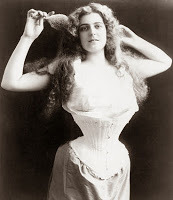 It has been thus in America since before the Civil War. In an era when tan skin was unacceptable, Thomas Jefferson wrote this to a devoted daughter: "Remember ... not to go out without your bonnet because it will make you very ugly and then we should not love you so much." Jefferson may have had a way with words when it came to authoring political documents, but I gotta say he could have used a little coaching when it came to communicating on the subject of beauty. Ahem.In the 1860s, the ideal waist measurement was 20 inches. T-w-e-n-t-y. Of course fashion designers were happy to create corsets to help women achieve the ideal. And physicians were equally happy to express their outrage at what such nonsense did to a woman's innards. But just as it does now, the desire to be desirable and to meet impossible standards of beauty waged unending war with common sense.
It has been thus in America since before the Civil War. In an era when tan skin was unacceptable, Thomas Jefferson wrote this to a devoted daughter: "Remember ... not to go out without your bonnet because it will make you very ugly and then we should not love you so much." Jefferson may have had a way with words when it came to authoring political documents, but I gotta say he could have used a little coaching when it came to communicating on the subject of beauty. Ahem.In the 1860s, the ideal waist measurement was 20 inches. T-w-e-n-t-y. Of course fashion designers were happy to create corsets to help women achieve the ideal. And physicians were equally happy to express their outrage at what such nonsense did to a woman's innards. But just as it does now, the desire to be desirable and to meet impossible standards of beauty waged unending war with common sense.According to Gail Collins, author of America's Women, "while virtually everything women read told them that corsets were bad, everything they saw stressed how essential they were." And it didn't end in the 1860s. After all, an 1880s woman wasn't going to achieve this:
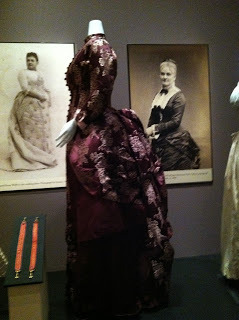 without this:
without this: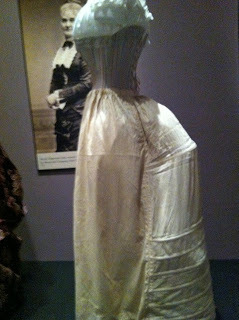
Harriet Beecher Stowe (1811-1896) wrote: "We in America have got so far out of the way of a womanhood that has any vigor of outline or opulence of physical proportion that, when we see a woman made as a woman ought to be, she strikes us as a monster ... Our willowy girls are afraid of nothing so much as growing stout ..."
Did your mother wear a corset? I was born in 1952 and advertising copy back then mentioned that "every woman has a figure problem."
And so it goes. The older I get, the more I struggle with the impossible standard. After all, at 79 Sophia Loren "rocked" the red carpet.
The more things change, the more they stay the same. Civil War ladies didn't want dark skin, but today we try to achieve it with everything from beach days to tanning beds to spray-on foam. So what is considered "beautiful" does change ... but the role of advertising and impossible standards in our quest isn't new.
As a wise man from the East once said ...
"That which has been is that which will be,
And that which has been done is that which will be done.So there is nothing new under the sun."
Published on December 18, 2013 16:12
November 6, 2013
A Mourning Event, Part I
"I'm going to a mourning event this weekend ... wanna come?"
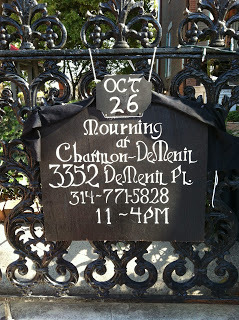
Not an invitation you hear often, eh? But when I saw news of the event on the web site for the Chatillon-Demenil House in St. Louis, Missouri, I was intrigued. I'm always interested in historic mansions, but I'd never been to a "mourning event." I have, however, had to research mourning customs, most recently for my book The Shadow on the Quilt. I'm very glad I made the effort to go. The event was well planned and very informative. I found it fascinating.
Attendees were welcomed with the sign at the right placed on the wrought iron fence that borders the back of the property. Friends and fellow authors Judith Miller and Nancy Moser and I purchased our tickets and made our way up the sidewalk that ran alongside the house toward the front door. Why did we go in the back way? Well, the front of the house looks out on an access ramp to an interstate. It's sad that the house just barely escaped being razed, and that "the view" isn't exactly inspiring. Still, the mansion was saved and it's cared for by a group of dedicated people.
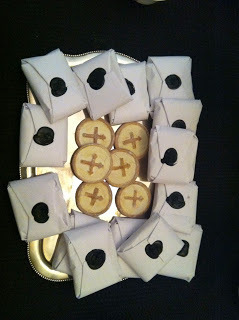 Each room of the house was dedicated to a certain aspect of Victorian mourning. First, we met a widow in the first stage of mourning. Then we moved into another room where a widow in the second stage of mourning showed examples of mourning stationery and other ephemera. The dining room table was set with mourning china, complete with a tray of funeral biscuits. In the upstairs hall, another mourner told us about one of the great enemies of children in the 19th century--diphtheria. In another room, a nurse shared some of the things she'd used to treat an ill patient and warned us of the importance of keeping a button on our person at all times, so that if a funeral procession happened to pass by, we could hold onto the button and keep Death from stalking us. Mary Todd Lincoln shared her experience with grief. Back on the main floor, the undertaker greeted us in the formal parlor. Each reenactor seemed very well informed, and I learned something new from each one--and came home with a new appreciation for how different things were in the 1800s, when saying good-bye to loved ones was based in the home.
Each room of the house was dedicated to a certain aspect of Victorian mourning. First, we met a widow in the first stage of mourning. Then we moved into another room where a widow in the second stage of mourning showed examples of mourning stationery and other ephemera. The dining room table was set with mourning china, complete with a tray of funeral biscuits. In the upstairs hall, another mourner told us about one of the great enemies of children in the 19th century--diphtheria. In another room, a nurse shared some of the things she'd used to treat an ill patient and warned us of the importance of keeping a button on our person at all times, so that if a funeral procession happened to pass by, we could hold onto the button and keep Death from stalking us. Mary Todd Lincoln shared her experience with grief. Back on the main floor, the undertaker greeted us in the formal parlor. Each reenactor seemed very well informed, and I learned something new from each one--and came home with a new appreciation for how different things were in the 1800s, when saying good-bye to loved ones was based in the home.
The plate at the right is an example of the mourning china that was on display in the dining room.
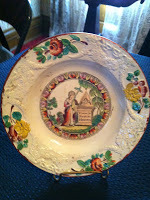 I didn't know such a thing existed!
I didn't know such a thing existed!
Commercial bakeries often vied for the "funeral biscuit" business ... just as they competed for wedding cake orders. In some areas, biscuits were distributed at the funeral luncheon or supper. In other parts of the country, they were delivered to family and friends as a way of sharing the news of a loss. Printed memorials were sometimes used for the wrapping paper, the packages closed with black sealing wax.
Overall, this was a fascinating and informative event. The next time I have to kill off a character, I'll know more about how that would have affected the survivors--well, the wealthy survivors, anyway. The "middling folk" wouldn't have been able to participate in such elaborate ritual.
In 2013, we sometimes lament the commercialization of holidays. In the late 1800s, furniture makers, florists, printers, bakers, dressmakers, musicians, stone masons, tailors and more all created product to support an entire industry. Mourning was big business. There is nothing new under the sun.
Posted by Stephanie Grace Whitson November 6, 2013

Not an invitation you hear often, eh? But when I saw news of the event on the web site for the Chatillon-Demenil House in St. Louis, Missouri, I was intrigued. I'm always interested in historic mansions, but I'd never been to a "mourning event." I have, however, had to research mourning customs, most recently for my book The Shadow on the Quilt. I'm very glad I made the effort to go. The event was well planned and very informative. I found it fascinating.
Attendees were welcomed with the sign at the right placed on the wrought iron fence that borders the back of the property. Friends and fellow authors Judith Miller and Nancy Moser and I purchased our tickets and made our way up the sidewalk that ran alongside the house toward the front door. Why did we go in the back way? Well, the front of the house looks out on an access ramp to an interstate. It's sad that the house just barely escaped being razed, and that "the view" isn't exactly inspiring. Still, the mansion was saved and it's cared for by a group of dedicated people.
 Each room of the house was dedicated to a certain aspect of Victorian mourning. First, we met a widow in the first stage of mourning. Then we moved into another room where a widow in the second stage of mourning showed examples of mourning stationery and other ephemera. The dining room table was set with mourning china, complete with a tray of funeral biscuits. In the upstairs hall, another mourner told us about one of the great enemies of children in the 19th century--diphtheria. In another room, a nurse shared some of the things she'd used to treat an ill patient and warned us of the importance of keeping a button on our person at all times, so that if a funeral procession happened to pass by, we could hold onto the button and keep Death from stalking us. Mary Todd Lincoln shared her experience with grief. Back on the main floor, the undertaker greeted us in the formal parlor. Each reenactor seemed very well informed, and I learned something new from each one--and came home with a new appreciation for how different things were in the 1800s, when saying good-bye to loved ones was based in the home.
Each room of the house was dedicated to a certain aspect of Victorian mourning. First, we met a widow in the first stage of mourning. Then we moved into another room where a widow in the second stage of mourning showed examples of mourning stationery and other ephemera. The dining room table was set with mourning china, complete with a tray of funeral biscuits. In the upstairs hall, another mourner told us about one of the great enemies of children in the 19th century--diphtheria. In another room, a nurse shared some of the things she'd used to treat an ill patient and warned us of the importance of keeping a button on our person at all times, so that if a funeral procession happened to pass by, we could hold onto the button and keep Death from stalking us. Mary Todd Lincoln shared her experience with grief. Back on the main floor, the undertaker greeted us in the formal parlor. Each reenactor seemed very well informed, and I learned something new from each one--and came home with a new appreciation for how different things were in the 1800s, when saying good-bye to loved ones was based in the home. The plate at the right is an example of the mourning china that was on display in the dining room.
 I didn't know such a thing existed!
I didn't know such a thing existed!Commercial bakeries often vied for the "funeral biscuit" business ... just as they competed for wedding cake orders. In some areas, biscuits were distributed at the funeral luncheon or supper. In other parts of the country, they were delivered to family and friends as a way of sharing the news of a loss. Printed memorials were sometimes used for the wrapping paper, the packages closed with black sealing wax.
Overall, this was a fascinating and informative event. The next time I have to kill off a character, I'll know more about how that would have affected the survivors--well, the wealthy survivors, anyway. The "middling folk" wouldn't have been able to participate in such elaborate ritual.
In 2013, we sometimes lament the commercialization of holidays. In the late 1800s, furniture makers, florists, printers, bakers, dressmakers, musicians, stone masons, tailors and more all created product to support an entire industry. Mourning was big business. There is nothing new under the sun.
Posted by Stephanie Grace Whitson November 6, 2013
Published on November 06, 2013 04:00
October 30, 2013
Hot Women of History: How Women Dealt With Heat and Hygiene.
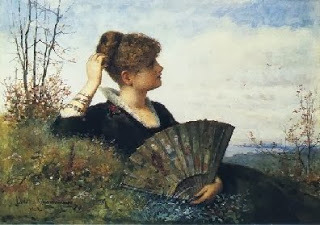 As I sit in my air-conditioned house and drive my air-conditioned car, wearing shorts, sandals, and a breezy cotton top, I wonder how women of the past dealt with hot weather. Thinking of all their layers upon layers makes me melt. Where’s my fan?
As I sit in my air-conditioned house and drive my air-conditioned car, wearing shorts, sandals, and a breezy cotton top, I wonder how women of the past dealt with hot weather. Thinking of all their layers upon layers makes me melt. Where’s my fan? So how did women tolerate the heat?
Perhaps part of the answer is simple: the change in seasons comes gradually, allowing the body time to adjust. Plus, it’s relative. Sixty degrees in April feels warm while sixty degrees in September feels cool. The body adjusts and fabrics change weight and color.
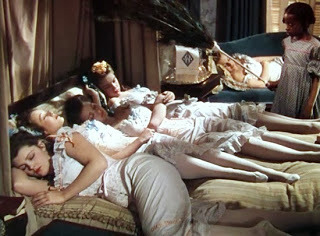
In “Gone With the Wind” the ladies at the barbecue retire to the shade-darkened bedrooms, strip down to their underwear and nap during the heat of the day. Daily schedules changed to fit the temperature. People often got up dawn, took a breather in the heat of the day, and went back to work in the cooler evenings.
During the late 1800’s, the wealthy families of the stifling east-coast cities moved their entire households to mansions that took advantage of the ocean breezes of Newport, Rhode Island. People with porches or basements slept wherever they could catch a breeze. Women carried parasols—which I found handy in Rome. Note my light-colored cotton clothing.
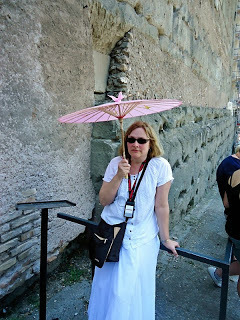 In the middle ages, the church thought nakedness was evil and baths could make you sick. Eventually logic prevailed. Later, washing the body, washing the face, and eliminating waste were achieved in three distinct areas: a portable bath tub in the kitchen near the heat source, a wash basin in the bedroom, and an outhouse. Or a chamber pot—which was emptied in a cess pit in the basement or outdoors. Putting all the functions in one place didn’t come about until the 1900’s.
In the middle ages, the church thought nakedness was evil and baths could make you sick. Eventually logic prevailed. Later, washing the body, washing the face, and eliminating waste were achieved in three distinct areas: a portable bath tub in the kitchen near the heat source, a wash basin in the bedroom, and an outhouse. Or a chamber pot—which was emptied in a cess pit in the basement or outdoors. Putting all the functions in one place didn’t come about until the 1900’s. If women were traveling, where did they relieve themselves? They could use outhouses at inns, or if in the country walk away from the wagon or stagecoach, lift their skirts and squat in the grass. Sometimes a fellow woman would spread a shawl or skirt to afford some privacy. There’s a scene in the movie, “Mrs. Brown” that shows Queen Victoria relieving herself in the woods. Pantaloons were often split in the middle which allowed for this amid all the other skirt layers.
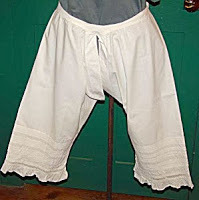 Now comes a question we rarely ask. How did women handle their periods? Pads and tampons have been around since ancient times. Moss, leather, and other fabrics were tied around waists or even inserted when wrapped around a stick. In some tribal cultures, women were ostracized during their periods. But for the most part rags were used, washed, and reused. And women of status often withdrew during that time, keeping to their rooms—which I suspect played into the image of females being weaker and more fragile than men.
Now comes a question we rarely ask. How did women handle their periods? Pads and tampons have been around since ancient times. Moss, leather, and other fabrics were tied around waists or even inserted when wrapped around a stick. In some tribal cultures, women were ostracized during their periods. But for the most part rags were used, washed, and reused. And women of status often withdrew during that time, keeping to their rooms—which I suspect played into the image of females being weaker and more fragile than men. People didn’t wash their clothes often either. To cover the stench they used perfume and pomanders. If everyone smelled, did they get used to it?
I am so glad I live when I do. Take a look at my Pinterest board: What a Lady Wore Beneath it All then check out over 2000 links to wonderful historical fashion! What could you give up: Air conditioning, a bathroom, or modern clothing?//Nancy
Published on October 30, 2013 16:00
September 12, 2013
The Roots of a Dream: The Transcontinental Railroad
Just released is my novel, The Journey of Josephine Cain, which places a spoiled rich girl from Washington D.C. smack dab in the middle of the building of the Transcontinental Railroad after the Civil War.
 It’s 1866. The Civil War has ended. Tens of thousands of war-weary soldiers need work—and beyond that, a purpose. They long for inspiration and a way to feel united again, a way to feel proud of their country.
It’s 1866. The Civil War has ended. Tens of thousands of war-weary soldiers need work—and beyond that, a purpose. They long for inspiration and a way to feel united again, a way to feel proud of their country.
Enter the Transcontinental Railroad project. Up until this time, if you wanted to travel from coast to coast, you could take a train as far as Council Bluffs, Iowa or Sacramento, California. Then you’d have to get off the train and go overland by stagecoach or wagon train. It would take six arduous months over mountains, deserts, and rivers.
Before the war, in August 1859, Abraham Lincoln was in Council Bluffs to check on some land that was collateral for a debt, and met with Grenville Dodge where they discussed the possibility of a transcontinental railroad stretching to the Pacific. They stood together on a bluff and looked west, and Dodge (who would become a brigadier general in the war) made a case for going directly across the prairie of the Nebraska territory. Since there was no bridge over the Missouri River between Council Bluffs and Omaha, it was logical to start the project in Omaha.
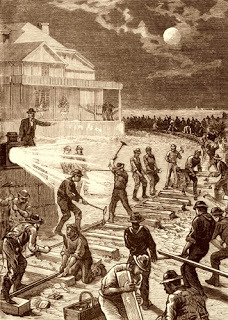 In 1862, after Lincoln became president, he signed the Pacific Railway Act and created the Union Pacific Railroad. Then he instructed the Union Pacific and Central Pacific to construct America’s first transcontinental railroad connecting Omaha and Sacramento, the Central Pacific heading east, and the Union Pacific heading west. Bonuses were given for miles of track laid, and promises of land for towns was enticing. A lot was at stake for many, many people.
In 1862, after Lincoln became president, he signed the Pacific Railway Act and created the Union Pacific Railroad. Then he instructed the Union Pacific and Central Pacific to construct America’s first transcontinental railroad connecting Omaha and Sacramento, the Central Pacific heading east, and the Union Pacific heading west. Bonuses were given for miles of track laid, and promises of land for towns was enticing. A lot was at stake for many, many people.
Work started in 1865 and was completed in May 1869 at Promontory Summit, Utah. During those four grueling years ex-Confederate soldiers worked side by side with ex-Union soldiers—and ex-slaves. Imagine that. A year earlier they were killing each other. It’s astonishing. And it wasn’t just Americans who worked on the project. Tens of thousands of immigrants left their homelands to work on the railroad. On the Central Pacific line Chinese workers were the prominent work force, and on the Union Pacific, the Irish led the way.
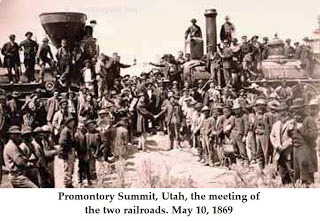 Men were paid varying wages according to their job: $2.50-4.00, or an average of $90/month. Yet the railroad deducted $20/month for food and board. The workers endured long days of backbreaking work, rough living conditions, harsh weather, and the threat of accidents and Indian attacks. Plus, as the railroads entered the Wild West, they came into contact with many people who’d come west to escape iffy pasts and held the law in disdain. Outlaws, shysters, murderers, and con men. Along the way, Hell on Wheel towns followed the crews—just like they’d followed the soldiers in the war—offering booze, gambling, and prostitution.
Men were paid varying wages according to their job: $2.50-4.00, or an average of $90/month. Yet the railroad deducted $20/month for food and board. The workers endured long days of backbreaking work, rough living conditions, harsh weather, and the threat of accidents and Indian attacks. Plus, as the railroads entered the Wild West, they came into contact with many people who’d come west to escape iffy pasts and held the law in disdain. Outlaws, shysters, murderers, and con men. Along the way, Hell on Wheel towns followed the crews—just like they’d followed the soldiers in the war—offering booze, gambling, and prostitution.
Why did the men do the work? It gave them food in their bellies, money in their pockets, and even more than that, pride in working toward something big, a project many called impossible. Because of their dedication and courage that six month trip from Omaha to Sacramento was cut down to a few days!
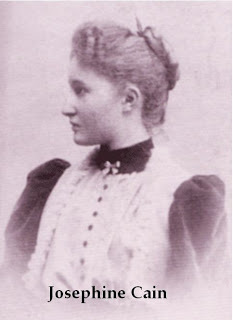 With all this drama and passion in the air it’s not surprising that a pampered general’s daughter from Washington D.C. would find herself a fish out of water. My character Josephine Cain has some choices to make when she is assailed with these rough experiences along the rails. She can choose to run home to what she knows, marry a family friend, and continue life according to the status quo. Or she can cower and be intimidated by the strange new world of the West. Or . . . she can be challenged by the possibilities, and tap into the strong woman she never knew she was. Guess which choice Josephine makes . . .
With all this drama and passion in the air it’s not surprising that a pampered general’s daughter from Washington D.C. would find herself a fish out of water. My character Josephine Cain has some choices to make when she is assailed with these rough experiences along the rails. She can choose to run home to what she knows, marry a family friend, and continue life according to the status quo. Or she can cower and be intimidated by the strange new world of the West. Or . . . she can be challenged by the possibilities, and tap into the strong woman she never knew she was. Guess which choice Josephine makes . . .
Come along on this amazing journey of discovery, courage, and faith and be a part of the American dream!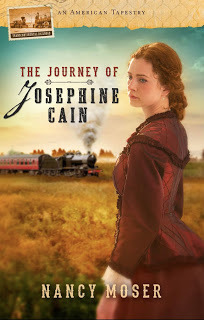 Read an excerpt from The Journey of Josephine Cain here. Buy it at your favorite bookstores: Amazon, Barnes & Noble, or Christian Book . It's available in paperback or eBook.
Read an excerpt from The Journey of Josephine Cain here. Buy it at your favorite bookstores: Amazon, Barnes & Noble, or Christian Book . It's available in paperback or eBook.
Check out Josephine's storyboard on Pinterest. and loads of 1860's fashion here!
 It’s 1866. The Civil War has ended. Tens of thousands of war-weary soldiers need work—and beyond that, a purpose. They long for inspiration and a way to feel united again, a way to feel proud of their country.
It’s 1866. The Civil War has ended. Tens of thousands of war-weary soldiers need work—and beyond that, a purpose. They long for inspiration and a way to feel united again, a way to feel proud of their country.Enter the Transcontinental Railroad project. Up until this time, if you wanted to travel from coast to coast, you could take a train as far as Council Bluffs, Iowa or Sacramento, California. Then you’d have to get off the train and go overland by stagecoach or wagon train. It would take six arduous months over mountains, deserts, and rivers.
Before the war, in August 1859, Abraham Lincoln was in Council Bluffs to check on some land that was collateral for a debt, and met with Grenville Dodge where they discussed the possibility of a transcontinental railroad stretching to the Pacific. They stood together on a bluff and looked west, and Dodge (who would become a brigadier general in the war) made a case for going directly across the prairie of the Nebraska territory. Since there was no bridge over the Missouri River between Council Bluffs and Omaha, it was logical to start the project in Omaha.
 In 1862, after Lincoln became president, he signed the Pacific Railway Act and created the Union Pacific Railroad. Then he instructed the Union Pacific and Central Pacific to construct America’s first transcontinental railroad connecting Omaha and Sacramento, the Central Pacific heading east, and the Union Pacific heading west. Bonuses were given for miles of track laid, and promises of land for towns was enticing. A lot was at stake for many, many people.
In 1862, after Lincoln became president, he signed the Pacific Railway Act and created the Union Pacific Railroad. Then he instructed the Union Pacific and Central Pacific to construct America’s first transcontinental railroad connecting Omaha and Sacramento, the Central Pacific heading east, and the Union Pacific heading west. Bonuses were given for miles of track laid, and promises of land for towns was enticing. A lot was at stake for many, many people. Work started in 1865 and was completed in May 1869 at Promontory Summit, Utah. During those four grueling years ex-Confederate soldiers worked side by side with ex-Union soldiers—and ex-slaves. Imagine that. A year earlier they were killing each other. It’s astonishing. And it wasn’t just Americans who worked on the project. Tens of thousands of immigrants left their homelands to work on the railroad. On the Central Pacific line Chinese workers were the prominent work force, and on the Union Pacific, the Irish led the way.
 Men were paid varying wages according to their job: $2.50-4.00, or an average of $90/month. Yet the railroad deducted $20/month for food and board. The workers endured long days of backbreaking work, rough living conditions, harsh weather, and the threat of accidents and Indian attacks. Plus, as the railroads entered the Wild West, they came into contact with many people who’d come west to escape iffy pasts and held the law in disdain. Outlaws, shysters, murderers, and con men. Along the way, Hell on Wheel towns followed the crews—just like they’d followed the soldiers in the war—offering booze, gambling, and prostitution.
Men were paid varying wages according to their job: $2.50-4.00, or an average of $90/month. Yet the railroad deducted $20/month for food and board. The workers endured long days of backbreaking work, rough living conditions, harsh weather, and the threat of accidents and Indian attacks. Plus, as the railroads entered the Wild West, they came into contact with many people who’d come west to escape iffy pasts and held the law in disdain. Outlaws, shysters, murderers, and con men. Along the way, Hell on Wheel towns followed the crews—just like they’d followed the soldiers in the war—offering booze, gambling, and prostitution. Why did the men do the work? It gave them food in their bellies, money in their pockets, and even more than that, pride in working toward something big, a project many called impossible. Because of their dedication and courage that six month trip from Omaha to Sacramento was cut down to a few days!
 With all this drama and passion in the air it’s not surprising that a pampered general’s daughter from Washington D.C. would find herself a fish out of water. My character Josephine Cain has some choices to make when she is assailed with these rough experiences along the rails. She can choose to run home to what she knows, marry a family friend, and continue life according to the status quo. Or she can cower and be intimidated by the strange new world of the West. Or . . . she can be challenged by the possibilities, and tap into the strong woman she never knew she was. Guess which choice Josephine makes . . .
With all this drama and passion in the air it’s not surprising that a pampered general’s daughter from Washington D.C. would find herself a fish out of water. My character Josephine Cain has some choices to make when she is assailed with these rough experiences along the rails. She can choose to run home to what she knows, marry a family friend, and continue life according to the status quo. Or she can cower and be intimidated by the strange new world of the West. Or . . . she can be challenged by the possibilities, and tap into the strong woman she never knew she was. Guess which choice Josephine makes . . . Come along on this amazing journey of discovery, courage, and faith and be a part of the American dream!
 Read an excerpt from The Journey of Josephine Cain here. Buy it at your favorite bookstores: Amazon, Barnes & Noble, or Christian Book . It's available in paperback or eBook.
Read an excerpt from The Journey of Josephine Cain here. Buy it at your favorite bookstores: Amazon, Barnes & Noble, or Christian Book . It's available in paperback or eBook.Check out Josephine's storyboard on Pinterest. and loads of 1860's fashion here!
Published on September 12, 2013 07:36
September 4, 2013
I bought three elephants this week.
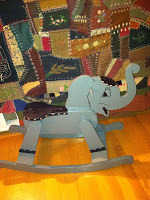 Really. This little guy on the right was at a local rummage store and my grand-kids have already gotten far more than seven dollars worth of joy out of it. Isn't he adorable?
Really. This little guy on the right was at a local rummage store and my grand-kids have already gotten far more than seven dollars worth of joy out of it. Isn't he adorable?I imagine some grandpa working in his shop, cutting the pieces, painting the gray ... and then outlining the "saddle" and the cap with those little silver brads. Just too cute not to bring home.
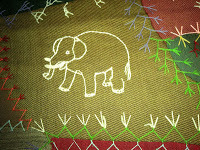 The other two elephants are one-dimensional, embroidered by an unknown hand onto a crazy quilt I won on an online auction. What inspired the maker? Did she love the circus? Had the circus just come through town?
The other two elephants are one-dimensional, embroidered by an unknown hand onto a crazy quilt I won on an online auction. What inspired the maker? Did she love the circus? Had the circus just come through town?Imagine seeing a live elephant for the first time ... perhaps the only time in a lifetime of days spent on the prairie in the 1800s. The biggest of the two elephants has blue eyes. I love that touch of whimsy ... and even though this quilt is far from "fine" and even though no one else seemed to want it, I'm glad to give it a home. It makes me smile. I think there may be a bit of circus research in my future. I keep remembering sepia-toned photographs I've seen somewhere, of pachyderms making their way down a dusty street in small Nebraska town.
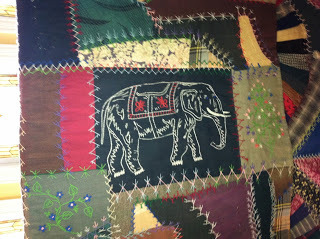
Published on September 04, 2013 18:58
July 22, 2013
Eye Miniatures
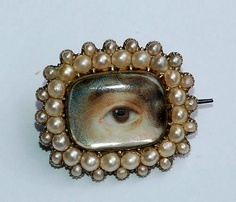 I was scanning through Pinterest (an addiction--at least I admit it) and saw some "eye miniatures". I had never heard of such a thing. But apparently in the late 1700's people would commission a portrait of their loved one's eyes. Or eye. Just one.
I was scanning through Pinterest (an addiction--at least I admit it) and saw some "eye miniatures". I had never heard of such a thing. But apparently in the late 1700's people would commission a portrait of their loved one's eyes. Or eye. Just one.The art was usually watercolor on ivory and was made into a brooch, bracelet, or ring. They're actually quite amazing. If the eyes are the door to one's soul, then I can imagine wanting to capture that image for all time.
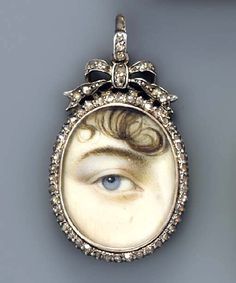
It's said that George III(England's king who wouldn't let the 13 American colonies go) had a mistress who gave him a portrait of her eye. Of course, when that's all there is in the portrait, it's hard to identify who the eye belongs to. Quite perfect for lovers and mistresses, and hence they were called "Lovers' Eyes". But eventually, it became a more sentimental keepsake for family members.
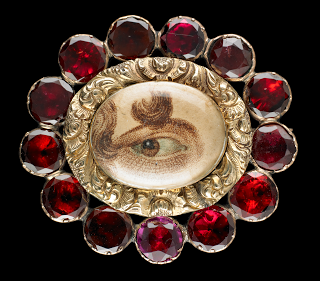
They can be quite pricey to collect, from $1000 to $20,000.
But beware the fake! Here's a fascinating article about it (and Antiques Road Show) here.
I also found a book about them.
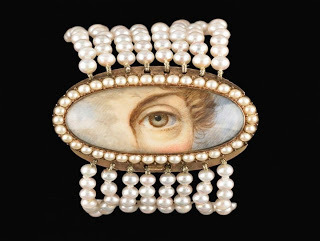
All these painted eyes seem quite lovely, but are missing one thing.
Wrinkles.
You can't convince me that none of the subjects had crow's feet.
Sorry. Sometimes I'm just too practical. Where is my romantic side? Lost in the past, no doubt.
Take a look at my Pinterest board that has loads of Antiques and Vintage Fascinations. Check out these other links to the boards I have about fashion (from most every era), accessories, underwear and corsets, portraits, jewels, history that intrigues me ... Once there, click on the boards to Follow me! (saying that I feel like the character in the movie "Indiana Jones and the Last Crusade")
If you're new to Pinterest, let me warn you, it's addictive. But in a nice way.//Nancy
Published on July 22, 2013 12:15
July 16, 2013
Spool Furniture
Spool Furniture
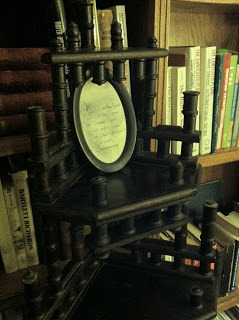 Have you seen the vintage shelving & etc. that's made of wooden spools? I tend to think it must be from the depression era (use it up, make it last, make it do, do without), although I don't really know, and looking around a bit on the internet I've seen some pieces that are called "nineteenth century," so perhaps my recently acquired treasure is older than I thought it was.
Have you seen the vintage shelving & etc. that's made of wooden spools? I tend to think it must be from the depression era (use it up, make it last, make it do, do without), although I don't really know, and looking around a bit on the internet I've seen some pieces that are called "nineteenth century," so perhaps my recently acquired treasure is older than I thought it was.
I have yearned from some little something made from spools over the years ... probably because I love old sewing stuff in general. Mostly I love the tactile connection to the woman who used the stuff. Which is why I litter my office with things like tatting shuttles (don't tat), needles for filet crochet (don't crochet), pin cushions (how many does one woman really need), and assorted other sewing gadgetry that is easy to store but still evocative of another time. I even have a metal box of attachments for a New Home sewing machine. But I don't have a New Home sewing machine. Go figure.
At any rate, this past month I took my annual pilgrimage to Nashville with my best road-dog friend. We made all the usual stops at this quilt shop and that flea market, and the corner shelf/what-not joined the other treasures in our over-full rented SUV. Now it sits right here to the left of my desk. And it makes me smile. Over 100 wooden sewing spools ... put to very good use ... at least I think so. Recyling isn't new!
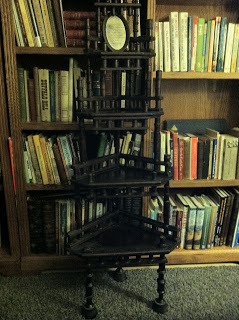
Here's a spool lamp: http://www.laurelleaffarm.com/viewitem.htm?itemNumber=u2825#.Ud3URPm7KAg
and a table:
http://branfordhouseantiques.com/cgi-bin/p/awtp-product.cgi?d=branford-house-antiques&item=53839
and a chair that looks more like a throne:
http://www2.ljworld.com/photos/2009/sep/27/178088/
I remember using very large spools as step-stools when my children were little ... but I don't know what they were originally used for (wire of some kind, I suppose) or where they went. Now that I have grandchildren, a little step-up would come in handy, and those things were untippable!
What example of recycling do you treasure?
 Have you seen the vintage shelving & etc. that's made of wooden spools? I tend to think it must be from the depression era (use it up, make it last, make it do, do without), although I don't really know, and looking around a bit on the internet I've seen some pieces that are called "nineteenth century," so perhaps my recently acquired treasure is older than I thought it was.
Have you seen the vintage shelving & etc. that's made of wooden spools? I tend to think it must be from the depression era (use it up, make it last, make it do, do without), although I don't really know, and looking around a bit on the internet I've seen some pieces that are called "nineteenth century," so perhaps my recently acquired treasure is older than I thought it was.I have yearned from some little something made from spools over the years ... probably because I love old sewing stuff in general. Mostly I love the tactile connection to the woman who used the stuff. Which is why I litter my office with things like tatting shuttles (don't tat), needles for filet crochet (don't crochet), pin cushions (how many does one woman really need), and assorted other sewing gadgetry that is easy to store but still evocative of another time. I even have a metal box of attachments for a New Home sewing machine. But I don't have a New Home sewing machine. Go figure.
At any rate, this past month I took my annual pilgrimage to Nashville with my best road-dog friend. We made all the usual stops at this quilt shop and that flea market, and the corner shelf/what-not joined the other treasures in our over-full rented SUV. Now it sits right here to the left of my desk. And it makes me smile. Over 100 wooden sewing spools ... put to very good use ... at least I think so. Recyling isn't new!

Here's a spool lamp: http://www.laurelleaffarm.com/viewitem.htm?itemNumber=u2825#.Ud3URPm7KAg
and a table:
http://branfordhouseantiques.com/cgi-bin/p/awtp-product.cgi?d=branford-house-antiques&item=53839
and a chair that looks more like a throne:
http://www2.ljworld.com/photos/2009/sep/27/178088/
I remember using very large spools as step-stools when my children were little ... but I don't know what they were originally used for (wire of some kind, I suppose) or where they went. Now that I have grandchildren, a little step-up would come in handy, and those things were untippable!
What example of recycling do you treasure?
Published on July 16, 2013 17:30
June 5, 2013
Name This Character. Please.
Names are my nemesis.
I can find faces. I spent a lovely couple of hours yesterday finding faces and "auditioning" them on the toile-covered board in my office.
... but names. ARRRGHHH.
The fact that I've already used so many names in past books complicates things immensely.
So many of the women's names I like have already been "taken."
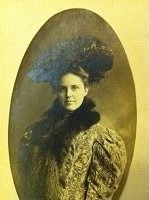 So here's "her" photo. The clothing is wrong, by the way. It's only 1861 in the book and this is probably more 1890s (the leg o'mutton sleeves on the coat are a dead give-away), but that face---perfect.
So here's "her" photo. The clothing is wrong, by the way. It's only 1861 in the book and this is probably more 1890s (the leg o'mutton sleeves on the coat are a dead give-away), but that face---perfect.
This is my leading lady.
Do you see Jenny, Lydia, Madaline (I suppose she would be called Maddie?), Rosalie,or some other name I haven't considered?
By the way, I collect names from historical documents and tombstones, just to make sure it's a name that was in use.
In this case it would have to have been in use in 1843 when my leading lady was born.
It isn't a contest, but I'd appreciate your input. And if I choose the name you suggested, I promise to thank you when I write the acknowledgements ... and I'll send you a free book when it's available next spring (this book doesn't release until spring of 2014). Well, there you go ... maybe it is a contest, after all.
Blessings!Stephanie G.
I can find faces. I spent a lovely couple of hours yesterday finding faces and "auditioning" them on the toile-covered board in my office.
... but names. ARRRGHHH.
The fact that I've already used so many names in past books complicates things immensely.
So many of the women's names I like have already been "taken."
 So here's "her" photo. The clothing is wrong, by the way. It's only 1861 in the book and this is probably more 1890s (the leg o'mutton sleeves on the coat are a dead give-away), but that face---perfect.
So here's "her" photo. The clothing is wrong, by the way. It's only 1861 in the book and this is probably more 1890s (the leg o'mutton sleeves on the coat are a dead give-away), but that face---perfect. This is my leading lady.
Do you see Jenny, Lydia, Madaline (I suppose she would be called Maddie?), Rosalie,or some other name I haven't considered?
By the way, I collect names from historical documents and tombstones, just to make sure it's a name that was in use.
In this case it would have to have been in use in 1843 when my leading lady was born.
It isn't a contest, but I'd appreciate your input. And if I choose the name you suggested, I promise to thank you when I write the acknowledgements ... and I'll send you a free book when it's available next spring (this book doesn't release until spring of 2014). Well, there you go ... maybe it is a contest, after all.
Blessings!Stephanie G.
Published on June 05, 2013 14:18



